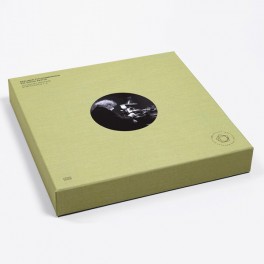Berliner Philharmoniker Sir Simon Rattle Brahms Symphonies 1-4 Direct To Disc 6LP 180g Vinyl Box Set
Title: Brahms Symphonies 1-4
Catalog Number: 160041
Label: Berliner Philharmoniker Recordings
Barcode: 4260306180417
Edition: Limited Collectors Edition
Original release year: 2016
Number of discs: 6
Revolutions per minute: 33⅓ rpm
Disc size: 12"
Vinyl Weight Grade: 180gr
Limited Edition: Yes
Numbered Edition: Yes
Total Item Weight: 3300gr
Pressing country: EU
For Market Release in: EU
Added to catalog on: January 20, 2017
Note: Not eligible for any further discounts
Vinyl Gourmet Club: No
Direct To Disc represents the ultimate in analog recording quality. With no intervention or post-processing, the sound is cut directly to a master disc at the moment of the performance in a complex end-to-end analog process. Now it was used to document a performance cycle of Brahms’s symphonies by the Berliner Philharmoniker and Sir Simon Rattle, available in an exclusive and limited 6LP Box.
Rated 11/11 Music and 09/11 Sound by Michael Fremer (Analog Planet)
- Limited and Numbered Edition (1833 units)
- 180 Gram Vinyl 6LP Box Set
- Direct-to-Disc Recording with One-Point Microphone Setup
- Certificate hand-signed by producer Rainer Maillard
- 2 C-type photo prints from recording sessions
- Exclusive vinyl release not available in any other format
Direct to disc: this term represents the ultimate in analogue recording quality. With no intervention and without any post-processing, the sound is cut directly into a master disc at the moment of the performance – the basis for a vinyl release of unique tonal authenticity. This complex, end-to-end analogue process is rarely used in today's digital age. Now, it was used to document a performance cycle of all of Brahms’s symphonies by the Berliner Philharmoniker and Sir Simon Rattle, and the result is available in an exclusive and limited vinyl edition.
Since the orchestra was established in 1882, the Berliner Philharmoniker have had a special relationship with Johannes Brahms, who also conducted the orchestra himself. Performances of his symphonies have always been a focal point of each chief conductor’s term of office, including Sir Simon Rattle under whose direction the Berliner Philharmoniker have given performances and made recordings of this music whose exemplary status has been testified to. Consequently, it seemed only natural to use the direct to disc process for this performance of Brahms’s symphonies with the Berliner Philharmoniker. Another feature is the purist recording method, using just one single pair of stereo microphones. In this way, a sound was able to be captured that is extraordinarily close to the original acoustics of the Philharmonie.
The Brahms cycle in the direct to disc process is only on release in the Berliner Philharmoniker Recordings vinyl edition and not on any digital medium. Corresponding to Johannes Brahms’s year of birth, it is limited to 1833 copies worldwide. The edition, produced to a particularly high standard, and with a comprehensive accompanying book, is not only a collector’s item for every vinyl fan – it also embodies a milestone in the rich media history of the Berliner Philharmoniker.
Sir Simon Rattle conducts the Berlin Philharmonic for this Direct-To-Disc recording of Brahms' Symphonic Cycle.
Since the orchestra was established in 1882, the Berliner Philharmoniker have had a special relationship with Johannes Brahms, who also conducted them himself. Performances of his symphonies have always been a focal point of each chief conductor's term of office, including Sir Simon Rattle under whose direction the Berliner Philharmoniker have given performances and made recordings of this music whose exemplary status has been testified to.
The performances from September 2014 documented here were recorded with just one single pair of stereo microphones which allows a sound to be captured that is extraordinarily close to the original acoustics of the Philharmonie. The sound was cut directly into the master disc via the shortest signal flow at the moment of performance. There was no subsequent processing and therefore no associated faults or copying losses. The process from recording to reproduction was entirely analogue. Through the elaborate recording and production process, this edition represents so to speak the optimum in analogue sound recording. Not only artistically, but also in terms of recording technology and craftsmanship, the present edition holds an outstanding position in the media history of the Berliner Philharmoniker.
"The... six LP box set of the four Brahms symphonies recorded direct-to-disc performed by Sir Simon Rattle and The Berlin Philharmonic before a live Philharmonie audience is as meticulously produced and presented as its existence is unlikely..."
"The almost half-ton Neumann VMS-80 lathe had to be carefully transported from the Emil Berliner Studios to the concert hall, which fortunately was but a third of a mile away. Once there it had to be re-calibrated and readied for the schedule, which consisted of the four Brahms symphonies performed twice within a two-week period...
"Of course neither the notes played nor the instrumental balance could be adjusted once they had been committed to lacquer. What’s more, unlike when cutting from tape, mastering engineer Maarten DeBoer could not make use of a preview head to “tell” the lathe how to adjust the groove pitch for louder, more dynamic passages, so he was left to do it manually by anticipating what was coming. Set the pitch too wide, too often and you run out of real estate. Set it too narrow and you risk groove overlap.
"Now add the pressure of having to replace the lacquer and start cutting “live” between movements and you begin to appreciate the high stakes for everyone involved. A red light on the podium visible only to the Maestro was his signal to cue the orchestra. After a series of rehearsals, the time between lacquer changes was reduced to but a few seconds, which, according to the annotation felt like “…an eternity to the participants…”.
"In between lacquers, according to the annotation, “Sir Simon bridged the time dabbing his foreheard”. The audience was never alerted to any of this “….in order to prevent psychological pressure from inadvertently increasing the tickle in the throat of cough-prone listeners.”
"Speaking of which, my first play through the six sides I didn’t notice a cough or a creaking seat until the first movement of Symphony Nr. 4, which was the second side of the fifth LP. In fact, I listened before reading any of the notes and wasn’t aware these were “live” in front of an audience recordings until the applause at the end of the first symphony..."
"The packaging is equal to the lavishly produced RCA Victor Soria series sets (named after the producer Dorle Soria) from the ‘late ‘50s and early ‘60s. The six LPs and hard covered book are housed in a notably sturdy canvas-clad (or canvas-like) box. The records are each in a plastic-lined sleeve that’s in a “library green” outer sleeve, the color of which well-complements the box’s pale green color. The hard covered seventy two-page book follows the canvas motif and is of equal high quality in terms of the paper stock, layout, printing and especially the content in both German and English.
"High quality photos are affixed to the page paper as in the old Soria series, which allows the use of really attractive paper stock. The look and feel of the book is “old school” excellence..."
"In some ways I’m reminded of Keith O. Johnson recordings: the spread is fifth row wide, but the perspective is more mid-hall. The sonic thrill here then is the fleshed out image three dimensionality and the transient delicacy. You “see” the strings and “feel” the textures in a very physical way. Brahms’ Third Symphony is his most disturbing and conflicted and when he uses the strings to sound the alarm, you’ll feel it."
"To be able to get a Brahms symphonic cycle performed by one of the world’s great orchestras and distinguished conductors, recorded AAA D2D minimally miked is no small miracle. That it was recorded live in performance makes it more vital. The performances are not cautious or tepid because lacquers were being cut and the intrusion of extraneous audience produced noises is mimimal to mostly non-existent... " - Michael Fremer, December 24, 2016, Analog Planet, 11/11 Music, 9/11 Sound
Johannes Brahms
Berliner Philharmoniker
Sir Simon Rattle, conductor
Symphony No. 1 in C minor, Op. 68
Symphony No. 2 in D major, Op. 73
Symphony No. 3 in F major, Op. 90
Symphony No. 4 in E minor, Op. 98
Recorded live at the Berlin Philharmonie in September 2014
Direct to Disc Recording - One-Point Microphone Setup
One pair of Sennheiser MKH 800 Twin in a Blumlein array
Disc cutting lathe Neumann VMS 80
Produced by Emil Berliner Studios
Rainer Maillard, Maarten de Boer
Certificate – hand-signed by recording producer Rainer Maillard
Two C-type photo prints of motifs from the recording sessions































Follow us